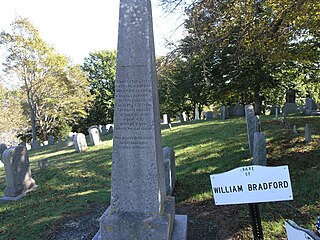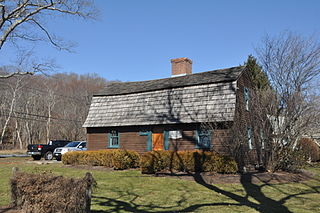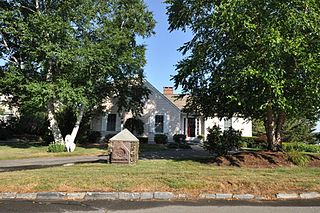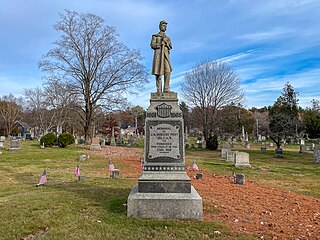
Fenwick is a borough in Middlesex County, Connecticut, United States, in the town of Old Saybrook. The borough is part of the Lower Connecticut River Valley Planning Region. The population was 53 at the 2020 census, making it the least populous borough in Connecticut. Most of the borough is included in the Fenwick Historic District, listed on the National Register of Historic Places. In 1995, the district included 66 contributing buildings and one other contributing site.

Old Saybrook is a town in Middlesex County, Connecticut, United States. The town is part of the Lower Connecticut River Valley Planning Region. The population was 10,481 at the 2020 census. It contains the incorporated borough of Fenwick, and the census-designated places of Old Saybrook Center and Saybrook Manor.

Old Lyme is a coastal town in New London County, Connecticut, United States, bounded on the west by the Connecticut River, on the south by the Long Island Sound, on the east by the town of East Lyme, and on the north by the town of Lyme. The town is part of the Lower Connecticut River Valley Planning Region.

The Saybrook Colony was an English colony established in New England in late 1635 at the mouth of the Connecticut River in what is today Old Saybrook, Connecticut. Saybrook was founded by John Winthrop the Younger, son of John Winthrop the Governor of the Massachusetts Bay Colony. Winthrop the Younger was designated titular Governor by the original settlers, including Colonel George Fenwick and Captain Lion Gardiner. They claimed possession of the land via a deed of conveyance from Robert Rich, 2nd Earl of Warwick, which granted the colony the land from the Narragansett River in modern Rhode Island to the Pacific Ocean. Winthrop named the colony in honor of William Fiennes, 1st Viscount Saye and Sele and Robert Greville, 2nd Baron Brooke, prominent Parliamentarians and the principal investors in the colony.

The Center Street Cemetery is a historic cemetery on Center Street in Wallingford, Connecticut. Established about 1670, it is the town's oldest cemetery, and the burial site for many of the city's civic and industrial leaders. It was listed on the National Register of Historic Places in 1997.

Route 154 is a state highway in Connecticut running for 28.24 miles (45.45 km). It serves as one of the main thoroughfares in the town of Old Saybrook, intersecting twice with U.S. Route 1. North of I-95, Route 154 runs parallel to Route 9, along to the west bank of the Connecticut River. The route ends in Middletown at Route 9.

Amherst West Cemetery is a historic cemetery on Triangle Street in Amherst, Massachusetts. The 4-acre (1.6 ha) cemetery was first laid out in 1730, when the voters of Hadley elected to establish a new burying ground in its eastern precinct. When the area was separated as Amherst in 1786, the property was taken over by the newly established town. In addition to being the burial site of many of Amherst's early settlers and American Civil War veterans, it is also the burial site of members of the Dickinson family, most notably the poet Emily Dickinson. Their family plot is set off from the rest of the cemetery by a wrought iron fence.

Center Cemetery is a historic cemetery on the south side of Sam Hill Road in Worthington, Massachusetts. The 2.4-acre (0.97 ha) cemetery was established c. 1774, and continues to be used today. Its burials include many of the founders and early settlers of Worthington, and of families influential in the growth and development of the town. The cemetery listed on the National Register of Historic Places in 2004.

Prospect Hill Cemetery is a historic cemetery on Auburn Road in Millis, Massachusetts. Founded in 1714, it is the town's only cemetery. Covering more than 18 acres (7.3 ha), it has more than 2,800 burials. Among those buried in the cemetery are politician Christian Herter, who served as U.S. Secretary of State and Governor of Massachusetts, and two Medal of Honor recipients, Charles Church Roberts and William D. Newland. The cemetery was listed on the National Register of Historic Places in 2006 with the help of a short documentary film by a Millis High School Freshman Dustin Fresh.

North Cemetery is a historic cemetery in Worthington, Massachusetts. The 3.5-acre (1.4 ha) municipal cemetery is located at the corner of Cold and North Streets not far from Worthington Corners; it is the town's largest cemetery. The cemetery was listed on the National Register of Historic Places in 2004, for its funerary architecture and its role as the burial ground for the town's early settlers.

Maple Street Cemetery is a historic cemetery on Maple Street in Adams, Massachusetts. Established about 1760, it is the town's oldest cemetery, serving as a burying ground for its early Quaker settlers, as well as for some of its prominent 19th-century citizens. It was listed on the National Register of Historic Places in 2004.

Old North Cemetery is a historic cemetery on North State Street in Concord, New Hampshire. Established in 1730, it is the city's oldest cemetery. Franklin Pierce, fourteenth president of the United States, is buried in the cemetery, as are his wife Jane and two of his three sons. It was listed on the National Register of Historic Places on November 9, 2008. The cemetery continues to accept new burials.

Burial Hill is a historic cemetery or burying ground on School Street in Plymouth, Massachusetts. Established in the 17th century, it is the burial site of several Pilgrims, the founding settlers of Plymouth Colony. It was listed on the National Register of Historic Places in 2013.

The Parker House is a historic house at 680 Middlesex Turnpike in Old Saybrook, Connecticut. It is a roughly square 1+1⁄2-story wood-frame structure with a gambrel roof, built in 1679 by Deacon William Parker. It is believed to be one of the oldest houses in the state, and was listed on the National Register of Historic Places in 1978.

Norwichtown is a historic neighborhood in the city of Norwich, Connecticut. It is generally the area immediately north of the Yantic River between I-395 and Route 169.

The Gideon Putnam Burying Ground is located on South Franklin Street in Saratoga Springs, New York, United States. It contains over 150 graves of early and mid-19th century residents of the city, all from the period between 1812 and 1871. It was restored in the 1980s after suffering from almost a century of neglect.

The North Cove Historic District encompasses a historic waterfront community on North Cove Road in Saybrook, Connecticut. Laid out in the 17th century, the area has housing stock mostly built between 1700 and 1855, a period in which it flourished as a port and shipbuilding community. The district was listed on the National Register of Historic Places in 1994.

The Old Saybrook South Green is a 20-acre (8.1 ha) historic district that encompasses the historic town green and nearby streets in Old Saybrook, Connecticut. Established in the 1630s, most of the buildings arrayed around the green were built between 1760 and 1900, and reflect the prosperity of the town, which was a major port and shipbuilding center. The district was listed on the National Register of Historic Places in 1976.

The Westbrook Town Center Historic District encompasses the historic town center of Westbrook, Connecticut. Roughly linear in shape, the district extends along the Boston Post Road, with its focal center at the junction with Essex Road. The area has been a center of civic activity since the early 18th century, even though Westbrook was not incorporated until 1840, and has residential, commercial, civic, and religious architecture covering three centuries. The district was listed on the National Register of Historic Places in 2017.

Evergreen Cemetery is an active cemetery at Evergreen and Cottage Streets in Medway, Massachusetts. Founded in 1750, it is one of the community's oldest cemeteries, with burials including many of its early families, as well as veterans of the American Revolutionary War and American Civil War. It also houses the burial of Joseph Barbur Jr., a regionally prominent funerary stone carver. The cemetery was listed on the National Register of Historic Places in 2021.





















